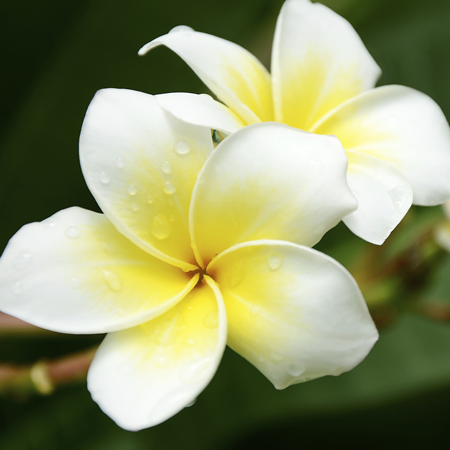


Botanical name Plumeria Alba
Source Seeds
Origin India
Processing Method Steam Distillation
Color/Consistency Pale Yellow clear liquid.
Aromatic Summary / Note / Strength of Aroma
Blends With Bergamot, Clary Sage, Clove Bud, Coriander Seed, Ginger, Grapefruit, Lemon, Mandarin, Neroli (Orange Blossom), Orange, Palmarosa, Patchouli, Petitgrain, Rose, Sandalwood and Ylang Ylang.
Product Abstract
Plumeria alba, commonly called white frangipani or nosegay, is a small rounded deciduous tree of the dogbane family that grows in a vase-shape to 15-25' tall. It features fragrant white flowers with yellow centers. Upright branches are thick but weak, and have a milky sap. This species is native to Puerto Rico and the Lesser Antilles, but has been introduced into a number of tropical areas around the world. Very fragrant 5-petaled flowers (to 3" wide) bloom in terminal clusters at the branch tips from spring to fall. Flowers are white with yellow centers. Oblong-lanceolate green leaves (to 12" long) are spirally clustered at the stem ends. Fruits are cylindrical pods (to 8") that are rarely formed in cultivation.
History
Plumeria Alba is often cultivated as an ornamental plant. In Cambodia pagodas especially choose this shrub, with the flowers used in ritual offerings to the deities, they are sometimes used to make necklaces which decorate coffins. In addition, the flowers are edible and eaten as fritters, while the heart of the wood is part of a traditional medical preparation taken as a vermifuge or as a laxative.
Harvesting/Extraction Information
Each pod yields 30 to 100 seeds, depending on the cultivar. When the seed pod has dried, take out the elongated tan seeds, which have a wing at one end and an enlarged portion at the other end. The enlarged portion is the embryo, which will grow into a new plant. Put the seeds into a paper envelope, and write the name of the parent plant or the cross you made on the outside of the envelope.
Common Usage
Caution
Dilute before use; for external use only. May cause skin irritation in some individuals; a skin test is recommended prior to use. Contact with eyes should be avoided.